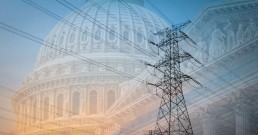Infrastructure Legislation Must Prioritize More Robust, Resilient Electric Grid
By John Kyte, strategic director, Protect Our Power
As Congress considers taking action to overhaul and rejuvenate the nation’s aging infrastructure, any legislative package should prioritize the U.S. electric grid.
Why?

Electricity powers our way of life — from manufacturing to providing clean water, from our farms and food supply to our hospitals and healthcare system, to our financial networks and the transportation sector, electricity makes it all work. An adequate, reliable, and affordable supply of electricity powers all other segments of our critical infrastructure and deserves priority status.
It is equally clear that the grid is under daily attack from a wide variety of sources. According to the FBI, DOE, Homeland Security, and any number of utility companies, attempts to penetrate computer systems, equipment, and digital control systems number in the millions per day. And while an event that shuts down our whole nation has not yet occurred, we cannot leave ourselves open to the possibility.
Our electric grid also needs overall modernizing and strengthening to accommodate changing energy sources. Electric generation from renewable sources continues to grow at a steady pace, raising both grid integration issues and the need to expand transmission capacity. In fact, a coalition of renewable energy and grid advocates, led by Microsoft founder Bill Gates, recently announced a campaign to support a nationwide build-out of transmission lines to help move power from the renewable resource-rich states where it is generated to the major population centers where it is consumed.
The continued electrification of transportation — cars, busses, trucks, trains, and someday even airplanes — will require not only more power eventually, but more grid security becomes ever more vital. The widespread and powerful charging networks these vehicles will require could provide pathways for hackers to disrupt the grid and pose unique problems for grid cybersecurity, according to experts and industry officials.
For example, fast, high-voltage chargers for medium- and heavy-duty electric vehicles present major vulnerability points to the grid that could give an attacker “unique opportunities to cause widespread harm” the National Motor Freight Traffic Association said in a 2018 cybersecurity review.
The ongoing growth of the Internet of Things, and the full-scale advent of 5G communications capability, also demand a more robust electric grid to meet increased energy usage, and a more secure and resilient grid to prevent potentially disabling access through literally billions and billions of interconnected devices and networks.
Placing a priority on efforts to make the grid more secure and resilient could provide a much-needed, job-producing economic boost following the pandemic. The U.S. electrical grid is the largest interconnected machine on Earth, involving approximately 3,000 utility companies, 200,000 miles of high-voltage transmission lines and 5.5 million miles of local distribution lines, linking thousands of generating plants to factories, homes, and businesses.
While no clear estimate of the cost to upgrade grid security and resiliency has been developed, the sheer size of the effort would likely cause a positive economic impact across the manufacturing, engineering and construction sectors, as well as along the supply chain and in the utility companies themselves.
Interestingly, a potentially innovative approach to funding such infrastructure investments was introduced in Congress just last week. The “Infrastructure Bank for America Act” would be capitalized by private investment and would “work with state and local partners to facilitate private infrastructure investment, creating a needed mechanism for states and municipalities to access necessary funding,” according to the bill’s author, Rep. Dan Webster, R-FL.
That legislation could perhaps complement the very detailed infrastructure improvement package outlined by the Congressionally appointed Cyberspace Solarium Commission in March. The CSC report provides a roadmap to successfully protecting our nation’s critical infrastructure and electric grid, including dozens of policy recommendations and more than 55 legislative proposals, detailing precisely how to implement a new and effective infrastructure cyber strategy.
Several things are clear: There is a growing and widely acknowledged need to enhance the cybersecurity and resiliency of the U.S. electric grid, and that need is only going to intensify as we further electrify and interconnect our society. The CSC has developed and provided to Congress a comprehensive plan for critical infrastructure improvements, including the electric grid, and a potential mechanism for funding the improvements has also been introduced in Congress.
The bottom line is that a major, extended power outage would be devastating to our nation, especially as we continue to battle the pandemic. Congressional action is imperative to jumpstart a comprehensive program to upgrade the security and resilience of the electric grid – the most important component of our critical infrastructure and the lifeblood of our economy.
It is time for the Administration and Congress to get on with the job, with the determination and seriousness of purpose that our national security and welfare deserve.
John Kyte
Author Bio